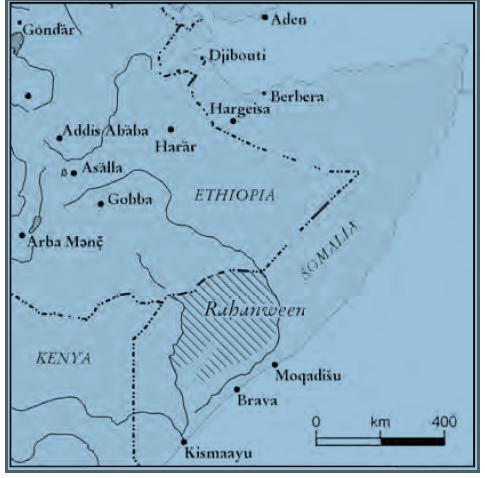
 Please wait...
Please wait...
-
@Everything Ethiopia 1+ years agoEverything there is to Ethiopia from around the web!
The ethnonym Rahanween (also Rahanweyn; Somali: Raxanweyn) refers to a Somali group composed of the two clan confederacies of Digil and Mirifle. They inhabit southern-central Somalia between the rivers Wabi Šäbälle and Juba. Together with the Daarood, Dir, Hawiye and Isaaq, they constitute the six clan families that make up the Somali nation. Whereas the latter four are large ly pastoral herders of camels, cattle, and flocks of sheep and goats, the Rahanween or “the Large Crowd”, practice a mixed economy of farming and herds- manship, growing corn, millet and sorghum, as well as keeping large herds of cattle and camels. On account of their living in the well-watered, fertile lands between the two rivers, the Rahanween are economically better off than the pastoralist clans who eke a precarious existence out of the harsh plains of the north-west. Consequently, the warlike famine driven pastoralists historically preyed on the pacific Rahanween plundering their livestock and pillaging their crops. However, the violence and anarchy of the last two decades have moved the Rahanween to organ ize and arm in order to defend themselves against the incursions of pastoral neighbours.
The Rahanween dialect of Somali, or May, is barely intelligible to the dominant pastoralists, or Mahay (Maxay), whose dialect is almost universally spo ken in the Somali peninsula. Furthermore, the R. social system is based on territoriality rather than agnatic descent; that is, group identity and sense of affiliation, belonging and loyalty stem from a common settlement in the same territory, and membership in a community is earned by virtue of having been born and grown up in that com- munity. Individuals from pastoral clans, for exam ple, who are born and raised among the Rahanween are adopted and integrated as authentic members of the R. Indeed, the vast majority of the Rahanween are composed of adoptive individuals and families, many of whom eventually rise to the status of malaaqs (‘ruling elders’) of their communities. A good ex- ample of this are the Geledi, who are one of the major sub-units of the Rahanween among which the sultan of Afgooye was chosen (Castagno 1975: 129; Cas- sanelli 1982). Though a reliable census does not exist for Somalia, the Rahanween by an informed guess, may be said to constitute a quarter of the popula- tion. The dominant culture in Somalia, however, is that of the pastoral clan-families. By contrast, pastoral social organization is based on strict ag-natic kinship relations. That is, group identity and belonging are based strictly on patrilineal descent and therefore shaped, inflexibly, by an organizing principle that social anthropologists refer to as the segmentary lineage system.
The Rahanween in the wake of the Somali civil war, suf- fered severe damage when the late warlord General Muhammad Farah Aydiid descended on them in 1994 with his Habar Gidir militia, who occupied them, wreaking havoc on people and property. In response the Rahanween appealed to Ethiopia against Aydiid’s occupation. The Ethiopians then intervened on behalf of the Rahanween ejecting General Aydiid and his troops. This was the beginning of Ethiopia’s intervention in the Somali civil war, leading to its wholesale invasion of southern Somalia on behalf of the Transitional Federal Government of Somalia, actively supported by the United States.
Source:
Encyclopaedia-Aethiopica
 Please wait...
Please wait...
 Loading content ...
Loading content ...
 Loading content ...
Loading content ...
 Please wait...
Please wait...
Similar topics
Similar topics
 Please wait...
Please wait...


